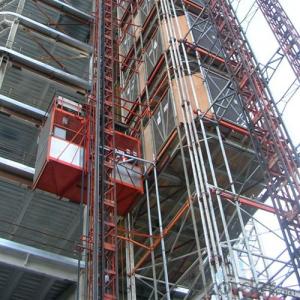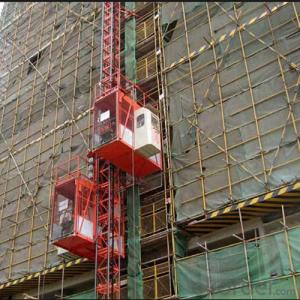SC100 Single cage construction hoist
- Loading Port:
- Shanghai
- Payment Terms:
- TT or LC
- Min Order Qty:
- -
- Supply Capability:
- 60 set/month
OKorder Service Pledge
OKorder Financial Service
You Might Also Like
SC200TD, SC200/200TD building hoist:
1). Cage load capacity: 2, 000kg
2). Lifting speed: 36m/min, 0 - 63m/min, 0 - 96m/min
3). Mast section: Painted or hot dipped zinc
4). Cage: Single cage or twin cage
5). Recommended cage inner dimensions (L x W x H): 2.5 x1.3 x 2.5m, 3.0 x 1.3 x 2.5m, 3.2 x 1.5 x 2.5m, 3.6 x 1.5 x 2.5m, 3.8 x 1.5 x 2.5m, 4.0 x 1.5 x 2.5m, 4.2 x 1.5 x 2.5m, according to requirements of customers
6). Motor and reducing device: Made in China, or uses SEW according to requirements
7). Counterweight: With counterweight or without counterweight
8). Color of cage: Yellow, red, blue
9). Cage load capacity: 1, 200kg, 2, 000kg, 2, 700kg or 3, 200kg
We offer most kinds for building hoist, if you are interested, please feel free to contact me.&
Single cage
· Rated Capacity: 2T
Lifting speed: 30m/min
Motor power: 2x13kW
Cage size (Length x width x height): 3x1.4x2.25m
Mast size (Length x width x height): 650x650x1508mm
Safety device: anti-dropping tripper
Mast weight: 124.2 kg(with one rack)
Loading information: 1*40 HQ can load 60m high SC200A construction hoist
Start directly
Simple structure and low cost
Convenience of installataion、dismantling and maintenance
Construction lift with Interver:
Characteristics | Model | Rated Loading | Lifting Speed | Motor Power | |
| | SC200/200D | 2 × 2000kg | 0-36m/min | 2 × (3 × 11kw) 2 × (2 × 13kw) |
SC100/100D | 2 × 1000kg | 0-36m/min | 2 × (2 × 11kw) | ||
| SC200/200Z | 2 × 2000kg | 0-60m/min | 2 × (3 × 15kw) | |
SC100/100Z | 2 × 1000kg | 0-60m/min | 2 × (2 × 15kw) | ||
| | SC200D | 2000kg | 0-36m/min | 3 × 11kw |
SC100D | 1000kg | 0-36m/min | 2 × 11kw | ||
| SC200Z | 2000kg | 0-60m/min | 3× 15kw | |
SC100Z | 1000kg | 0-60m/min | 2 × 15kw | ||
FAQ of Building Hoist
Q: What is the building hoist main purpose?
A: Building hoist equipped with double or single cabin to transport the materials and labors up and down. It's the ideal construction equipment for vertical transportation in the field of construction.
Q: What is the main structure of building hoist?
A: The P/M construction hoist mainly contains metal structure, driving system, electrical control system, cable guide & protection system, electrical top crane and safety device.
Q: What is the meaning of the building hoist’s code?
A: Take SC200/200 for example: “SC” stands for rack and pinion hoist, “200/200” stands for double cage and capacity is 2 tons per cage. “SC200” stands for single cage and capacity is 2 tons.
Q: What is the dimension of the cage?
A: Normally the cage dimension is 3X1.5X2.5M (L/W/H) for 2t type hoist. Details should be checked according to our quotation sheet. Also, the size can be customized according to the factual site condition. There are two doors (entrance & exit doors) for each cage, It can be produced as up & down sliding or ramping model for safety and convenience.


- Q: What about the energy efficiency of the escalator
- Variable frequency construction elevator energy saving effect general. Frequency conversion is not energy efficient. The difference between the frequency and the common machine is the smoothness and speed of the operation. Frequency conversion speeds up to 90m / 1 minutes and the average is only 35m / 1 min Frequency conversion when parking is slow down and stop Ordinary is directly stop delay parking and adjustment made door light who bow Angle decyl with brush spring connection will be better. The frequency conversion requires the site voltage to be strictly a little bit looser than the voltage requirement Energy consumption is: according to the elevator drive mechanism for general three transmission two kinds of the elevator are three 11 kw motor, that their energy consumption are 3 x 11 = 33 kw is hours each hanging basket consumes electricity 33 degrees, the actual power consumption will be bigger.
- Q: The construction elevator is commonly used in the process of the project
- Basically: completed from the main body - - complete completion
- Q: Is it possible to use a lifting device to assist in lifting an individual who is too tall for one person to lift safely?
- <p>Yes, you can use a lifting device to assist in lifting someone who is too tall for you to lift alone. These devices are designed to help in safely moving individuals who are heavier or taller than can be managed without assistance. It's important to ensure that the lifting device is appropriate for the person's weight and height, and that it is used correctly to avoid injury. Always follow the manufacturer's instructions and safety guidelines when using such equipment.</p>
- Q: The user is asking if it's possible to substitute a hydraulic lifting device for a building hoist in construction.
- <p>Yes, a hydraulic lifting device can be used as an alternative to a building hoist in certain scenarios. Hydraulic devices offer precise control and smooth operation, which can be advantageous for lifting heavy construction materials. However, it's important to consider the specific requirements of your project, such as the weight and size of the materials to be lifted, the height of the lift, and the frequency of use. Hydraulic systems are generally more expensive and require more maintenance than building hoists, but they can provide greater lifting capacity and versatility. Always ensure that any lifting device used complies with safety standards and regulations.</p>
- Q: Explain the benefits and drawbacks of using an electric winch compared to a building hoist.
- <p>Advantages of using an electric winch include ease of operation, lower noise levels, and the ability to be used in various environments. They are also more portable and can be easily moved between different locations. Disadvantages include higher initial costs compared to some building hoists, potential electrical hazards, and the need for regular maintenance to ensure safety. Additionally, electric winches may have lower lifting capacities compared to some building hoists, which could be a limitation for heavy construction tasks.</p>
- Q: This question asks about the various elements that can influence the efficiency and effectiveness of a building hoist.
- <p>The performance of a building hoist is affected by several factors including the type and weight of materials being lifted, the frequency of use, the hoist's mechanical condition and maintenance, environmental conditions such as wind and temperature, the skill and training of operators, and the design and capacity of the hoist itself. Proper installation, regular inspections, and adherence to safety protocols also play a crucial role in ensuring optimal performance and safety. Additionally, the quality of electrical systems, the efficiency of the drive mechanism, and the structural integrity of the hoist's components can significantly impact its operation.</p>
- Q: Why do you ask the construction elevator to be a certain distance from the structure? Is very close to if not you can not bother to do delivery channel security protection or something, out of the elevator out directly, and attachment should be able to get more easily, to solve. Thank you very much!!
- The distance between the moving parts and the building and the fixed construction equipment shall not be less than 0.25 m. The main thing is to prevent the person from the point of view. For example, workers are on the third floor to look down, hanging cage, where is the result now hanging basket is go down from the fourth floor, if not the 25 cm, likely to brush "cut".
- Q: Identify the elements that influence the durability and operational lifespan of lifting machinery, specifically focusing on Building Hoists.
- <p>The lifespan of lifting equipment, including Building Hoists, is influenced by several factors: 1) Material Quality: The type and quality of materials used in construction directly affect durability and resistance to wear and tear. 2) Design and Engineering: Proper design ensures optimal performance and reduces stress on components. 3) Frequency of Use: More frequent use can lead to faster wear and tear. 4) Maintenance and Repair: Regular maintenance can extend the lifespan, while neglect can shorten it. 5) Operating Conditions: Environmental factors such as temperature, humidity, and exposure to corrosive substances can impact longevity. 6) Load Capacity: Overloading can cause premature failure. 7) Compliance with Safety Standards: Adhering to safety guidelines can prevent accidents and damage. 8) Technological Advancements: Newer models may have improved features that extend lifespan.</p>
- Q: Is it permissible to use a building hoist for lifting people or animals?
- <p>No, building hoists are not designed for lifting people or animals. They are specifically engineered for the transportation of materials and construction equipment. Using a building hoist for this purpose is dangerous and can lead to accidents. It is essential to adhere to safety regulations and use appropriate equipment for lifting people or animals to ensure their safety and comply with legal standards.</p>
- Q: This question asks if it is permissible to use a building hoist for the purpose of lifting people.
- <p>No, a building hoist should not be used for lifting people. Building hoists are designed for the transportation of materials and equipment during construction, not for carrying personnel. Using a building hoist to lift people is dangerous and against safety regulations. It poses significant risks, including falls and equipment malfunctions, which can lead to serious injuries or fatalities. Always use designated personnel lifts or other safe methods for moving people in construction settings.</p>
Send your message to us
SC100 Single cage construction hoist
- Loading Port:
- Shanghai
- Payment Terms:
- TT or LC
- Min Order Qty:
- -
- Supply Capability:
- 60 set/month
OKorder Service Pledge
OKorder Financial Service
Similar products
Hot products
Hot Searches
Related keywords




























